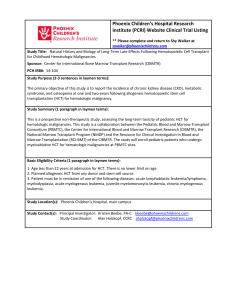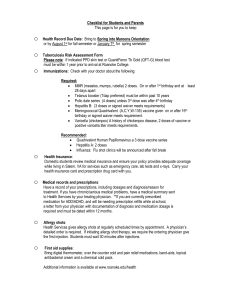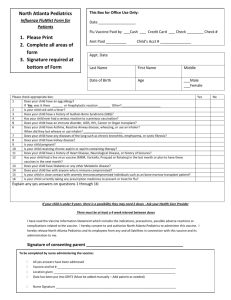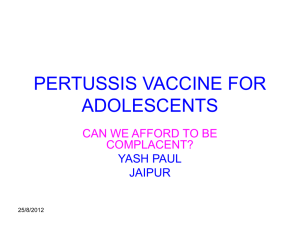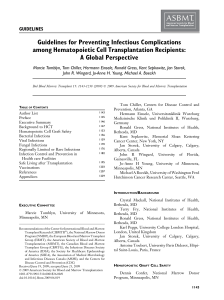APPENDIX TABLES
advertisement
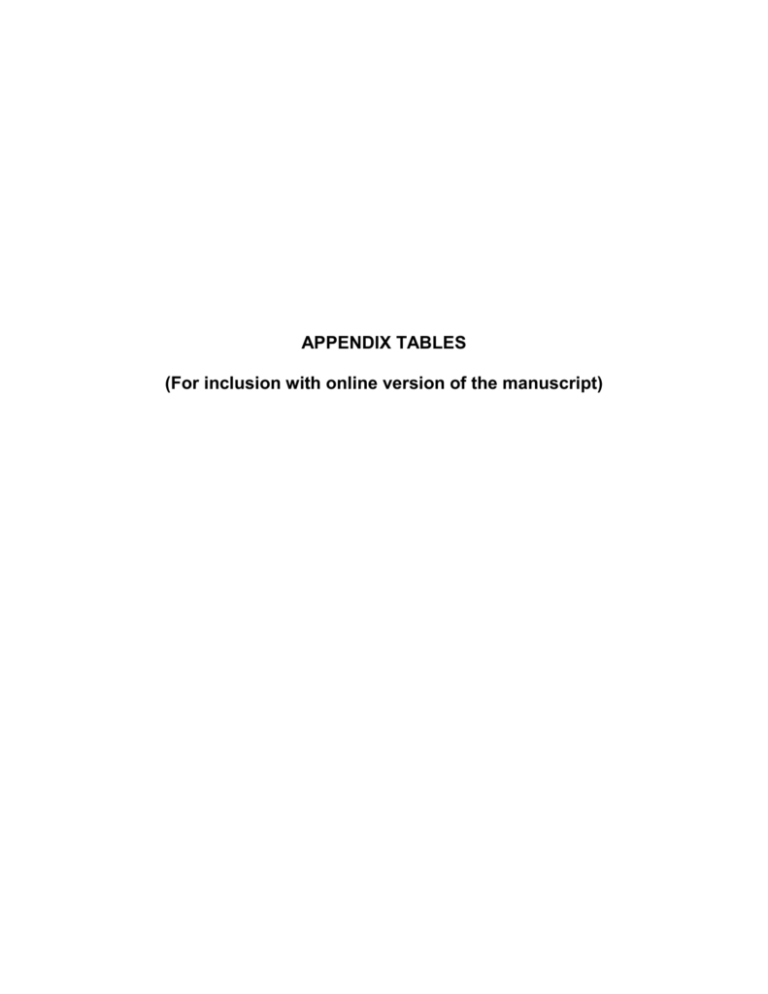
APPENDIX TABLES (For inclusion with online version of the manuscript) TABLE A: Vaccinations recommended for both autologous and allogeneic HCT recipients (Adapted from references 9-11) Vaccine Pneumococcal conjugate (PCV) Tetanus, diphtheria, acellular pertussis c Haemophilus influenzae conjugate Meningococcal conjugate Inactivated polio Recombinant hepatitis B Inactivated influenza Measles-mumps-rubella (live) f,g Recommended for use after HCT Yes Yes Yes Follow country recommendations for general population Yes Follow country recommendations for general population Yearly Measles: All children and seronegative adults Time post-HCT to initiate vaccine 3-6 months 6-12 months 6-12 months 6-12 months No. of doses a 3-4 b 3d 3 1 6-12 months 6-12 months 3 3 4-6 months 24 months 1-2 e 1-2 h Adapted from: “Guidelines for preventing infectious complications among hematopoietic cell transplantation recipients: A global perspective”, Biology of Blood and Marrow Transplantation, Volume 15, Issue 10, Pages 1143-1238, Copyright 2009, with permission from Elsevier; and “Vaccination of hematopoietic cell transplant recipients”, Bone Marrow Transplantation, Volume 44, Issue 8, Pages 521-526, Copyright 2009, with permission from Macmillan Publishers Ltd. Guidelines for vaccinations considered optional or not recommended for HCT recipients and for vaccinations for family, close contacts and healthcare workers of HCT recipients are available from these references. a b c d e f g h A uniform specific interval between doses cannot be recommended, as various intervals have been used in studies. As a general guideline, a minimum of 1 month between doses may be reasonable. Following the primary series of three PCV doses, a dose of the 23-valent polysaccharide pneumococcal vaccine (PPSV23) to broaden the immune response might be given. For patients with chronic GVHD who are likely to respond poorly to PPSV23, a fourth dose of the PCV should be considered instead of PPSV23. DTaP (diphtheria tetanus pertussis vaccine) is preferred, however, if only Tdap (tetanus toxoid-reduced diphtheria-toxoid reduced acellular pertussis vaccine) is available (for example, because DTaP is not licensed for adults), administer Tdap. Acellular pertussis vaccine is preferred, but the whole-cell pertussis vaccine should be used if it is the only pertussis vaccine available. See reference for consideration of an additional dose(s) of Tdap for older children and adults. For children <9 years of age, two doses are recommended yearly between transplant and 9 years of age. Measles, mumps and rubella vaccines are usually given together as a combination vaccine. In females with pregnancy potential, vaccination with rubella vaccine either as a single or a combination vaccine is indicated. Not recommended <24 months post-HCT, in patients with active GVHD and in patients on immune suppression. In children, two doses are favored. TABLE B: Recommendations for screening and prevention of late complications in long-term HCT survivors by selected exposures and risk-factors; this table highlights late complications that require greater vigilance or alternate followup schedule in this group of patients in addition to guidelines applicable for all HCT recipients (Table 1) Tissues/organs Monitoring Tests and Preventive Measures Pediatric HCT recipients Oral Nervous system Endocrine Yearly assessment of teeth development - Annual assessment for congnitive development milestones - Clinical and endocrinologic gonadal assessment for pre-pubertal boys and girls within 1 year of transplant, with further followup as determined in consultation with a pediatric endocrinologist - Monitor growth velocity annually; assessment of thyroid, and growth hormone function if clinically indicated Patients with active or history of chronic GVHD Immune system Ocular Oral Respiratory Muscle and connective tissue Skeletal Endocrine Mucocutaneous Second cancers - Antimicrobial prophylaxis targeting encapsulated organisms and PCP for the duration of immunosuppressive therapy - Screening for CMV reactivation should be based on risk factors, including intensity of immunosuppression. - Routine clinical evaluation, and if indicated, ophthalmologic examination more frequently than general recommendations of 6 months, 1 year and yearly thereafter - Consider more frequent oral and dental assesments with particular attention to intra-oral malignancy evaluation compared to general recommendations of 6 months, 1 year and yearly thereafter for clinical oral assessment and 1 year and yearly therafter for dental assessment - Some experts recommend clinical evaluation (± PFT’s) start before 6 months and occur more frequently than general recommendations of 6 months, 1 year and yearly thereafter - Physical therapy consultation in patients with prolonged corticosteroid exposure, fascitis or scleroderma - Frequent clinical evaluation by manual muscle tests or by assessing ability to go from sitting to standing position for patients on prolonged corticosteroids - Some experts recommend dual photon densitometry at an earlier date in patients with prolonged corticosteroid or calcineurin inhibitor exposure compared to general recommendations of 1 year - Slow terminal tapering of corticosteroids for those with prolonged exposure - Consider stress doses of corticosteroids during acute illness for patients who have received chronic corticosteroids - Consider more frequent gynecologic evaluation based on clinical symptoms compared to general recommendations of 1 year and yearly thereafter - Clinical and dental evaluation with particular attention towards oral and pharyngeal cancer - Counsel patients about risks of secondary malignancies annually, particularly of the oro-pharynx and skin, and encourage them to perform self exam (e.g., skin) Patients with prolonged pre- or post-transplant corticosteroid exposure Immune system Muscle and connective tissue Skeletal Endocrine - Antimicrobial prophylaxis targeting encapsulated organisms and PCP for the duration of immunosuppressive therapy - Screening for CMV reactivation should be based on risk factors, including intensity of immunosuppression. - Physical therapy consultation - Frequent clinical evaluation by manual muscle tests or by assessing ability to go from sitting to standing position - Some experts recommend dual photon densitometry at an earlier date compared to general recommendations of 1 year - Slow terminal tapering of corticosteroids for those with prolonged exposure - Consider stress doses of corticosteroids during acute illness for patients who have received chronic corticosteroids TBI recipients Mucocutaneous Second cancers - Consider more frequent gynecologic evaluation based on clinical symptoms compared to general recommendations of 1 year and yearly thereafter - Screening mammography in women starting at age 25 or 8 years after radiation exposure, whichever occurs later but no later than age 40 TABLE C: List of guidelines referenced in this manuscript and links to their websites Guideline (Reference) Long-term followup guidelines for survivors of childhood, adolescent and young adult cancers Guidelines for preventing infectious complications among hematopoietic cell transplantation recipients: A global perspective (9,10) Prevention of infective endocarditis: Guidelines from the American Heart Association (15) Third report of the expert panel on detection, evaluation and treatment of high blood cholesterol in adults (Adult Treatment Panel III) (36) Physical activity guidelines for Americans (77) Recommendations for the prevention and treatment of glucocorticoid-induced osteoporosis (52) Preventive health recommendations for adults* Preventive health recommendations for children and adolescents * * Includes guidelines for cancer screening Sponsor Children‘s Oncology Group (COG) Center for International Blood and Marrow Transplant Research (CIBMTR), the National Marrow Donor Program (NMDP), the European Blood and Marrow Transplant Group (EBMT), the American Society of Blood and Marrow Transplantation (ASBMT), the Canadian Blood and Marrow Transplant Group (CBMTG), the Infectious Diseases Society of America (IDSA), the Society for Healthcare Epidemiology of America (SHEA), the Association of Medical Microbiology and Infectious Diseases Canada (AMMI), and the Centers for Disease Control and Prevention (CDC) American Hearth Association (AHA) National Heart, Lung and Blood Institute (NHLBI) US Department of Health and Human Services (HHS) American College of Rheumatology (ACR) US Preventive Services Task Force (USPSTF) US Preventive Services Task Force (USPSTF) Website Link http://www.survivorshipguidelines.org/ http://www.ncbi.nlm.nih.gov/pubmed/19747629 http://www.ncbi.nlm.nih.gov/pubmed/19861977 http://circ.ahajournals.org/content/116/15/1736. full.pdf http://my.americanheart.org/professional/State mentsGuidelines/ByTopic/TopicsDH/Endocarditis_UCM_321487_Article.jsp http://circ.ahajournals.org/content/106/25/3143. long http://www.nhlbi.nih.gov/guidelines/cholesterol/ http://www.health.gov/paguidelines/ http://www.rheumatology.org/practice/clinical/g uidelines/osteoupdate.asp http://www.uspreventiveservicestaskforce.org/a dultrec.htm http://www.uspreventiveservicestaskforce.org/tf childcat.htm

